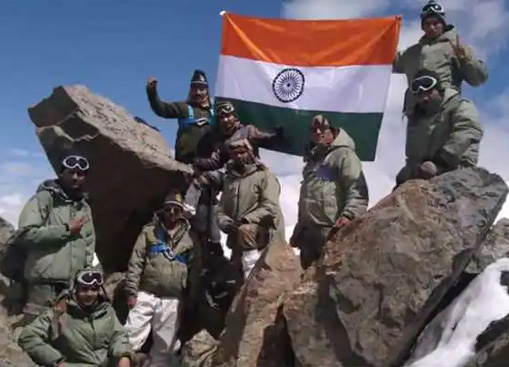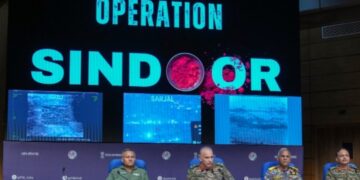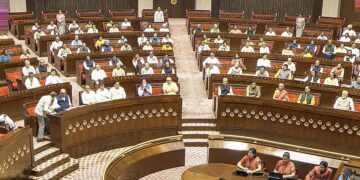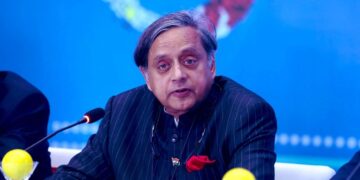Relations between India and Pakistan have never been cordial. War after war, the tensions have only escalated. 1948, 1965, 1971. Tensions between the two neighbours severed in the backdrop of the upsurge in Pakistan sponsored militancy in Kashmir valley in the early 1990s,and even more after the nuclear tests by both the countries in 1998. In order to diffuse the situation[c], India and Pakistan signed the Lahore Declaration in February 1999, when Prime Minister Atal Bihari Vajpayee went on his maiden visit to Pakistan on-board the newly launched Delhi-Lahore bus service.
While this was making global headlines, in the Operations room of Pakistan Army’s GHQ, Gen Pervez Musharraf was planning a large-scale infiltration across the LoC, to surreptitiously occupy dominating heights of Kargil. The infiltration was code-named Operation Badr.
Some posts on the Indian side of the LoC were occupied by Pakistani forces in as early as February of 1999, at the peak of winters, when infiltration was least expected by the Indian Army and most strategic points along the LoC lay deserted owing to extreme temperatures. Troops from Pakistan’s elite Special Services Group and the Northern Light Infantry covertly set up bases on 132 vantage points in the Indian-controlled region. These Pakistani forces were reportedly backed by Kashmiri Guerrillas and Afghan mercenaries. The bulk of inflation, however, occurred in April.
Three months after signing the declaration, Pakistan yet again backstabbed India.
Pakistani troops were spotted in the Northern sector of Ladakh by a shepherd on May 3rd 1999, and had captured a strategic and dominating location in the Kargil district overlooking the Srinagar-Kargil-Leh National highway no.1. The shepherd immediately tipped off HQ121 Infantry Brigade about the presence of intruders. The Indian Army and government was unaware of the large-scale invasion planned at the hands of Pakistan’ Army and the ISI. The apparent aim of the infiltration was to sever the link between Kashmir and Ladakh, and force Indian Forces to withdraw from the Siachen Glacier. [h]
Pakistan was also of the opinion that such a large-scale war will definitely garner international attention which will in turn force India to demarcate Indian and Pakistan territories.
Initially, Pakistan denied the involvement of its army in the war and claimed that it was caused by Kashmiri militants. However, documents left behind by war casualties, testimonies of Prisoners of War, and later statements by Pakistani Prime Minister Nawaz Sharif, as well as Army Chief Pervez Musharraf, told a different story.
On May 5th Captain Saurabh Kalia and his men first went to patrol the area after the tip-off. The men were taken captive by the Pakistani troops for 22 days, during which they faced unimaginable torture and their mutilated corpses were handed over to Indian authorities. Captain Saurabh Kalia was the first Prisoner of War of the Kargil conflict.
It was on May 10th that Pakistani infiltrators penetrated into Dras and Kaksar sectors across the LoC, and this is when the Indian Army launched Operation Vijay.
The flow of information was negligible, and the intelligence inputs were next to zero, it was concerted air reconnaissance which revealed that the infiltrators had occupied dominating heights and covered all approaches by observation and fire. The Indian Army had received particular directions to not cross the LoC at any cost, which limited its options to go in for frontal assaults.
Around 2 lakh troops were mobilized. But the nature of the terrain made division and corps level operations impossible and fighting was conducted mostly at the brigade or the battalion level. About 30,000 troops were actively engaged in war in the Kargil-Drass sector. At such heights, the challenge is not just to fight the enemy, but also temporary memory loss and frostbite.
By May 9th, heavy shelling from the Pakistani side had damaged the Indian Army’s ammunition dumps in Kargil.
MAY 11th By the middle of May, Indian Army had moved in more troops from Kashmir Valley to Kargil and The IAF was approached to provide air support on 11 May 99 with the use of helicopters. A go ahead was given only on May 25th by the Cabinet Committee on Security (CCS) to mount attacks on the infiltrators without crossing the LoC.
On May 26th, Indian Air Force began its airstrikes against suspected infiltrator locations under the code name Operation Safed Sagar. It was on May 27th that two aircrafts of the Indian Air Force, the MiG-21 and the MiG-27 were shot down by Pakistan Air Defence Corps’ surface to air missile- Anza. Flt. Lt. Nachiketa was flying the MiG-27 at the time, and was captured as Prisoner of War by the Pakistani Patrol. He was later released.
The next day, on May 28th, mi-17 helicopter of the Indian Air Force was shot down by Pakistani Forces. All four crew members on board lost their lives in the crash. By June 1st Pakistan had started shelling operations on the National Highway 1 connecting Kashmir to Ladakh, and about four days later, on June 5th, the Indian administration had released documents recovered from Pakistani casualties that officially indicated the involvement of Pakistan in the conflict.
The Indian Navy too jumped into action as soon as it was asked to. As part of operation Talwar, the western and eastern fleets of the navy came together in the Northern Arabian sea and threatened to cut Pakistan’s sea trade, which exploited Pakistan’s dependence on sea-based oil and trade. [s]Later, Pakistan’s Prime Minister Nawaz Sharif disclosed that in case a full-scale war breaks out, Pakistan will be left with just 6 days of fuel to sustain itself.
June 9th With tactical air support and more sound planning on the ground, the Indian Army had begun a major offensive in Kargil and by June 9th, two key positions in the Batalik sector were captured by the Indian Army.
June 11th Indian intelligence agencies had been intercepting key communication channels of Pakistan, and on 11th June, intercepts of conversation between Pakistan Army Chief General Pervez Musharraf and Lt. Gen Aziz Khan as proof of Pakistani Army’s involvement in the war. Gen Pervez Musharraf was on his visit to China at the moment, and Lt. Gen Khan was in Rawalpindi in the GHQ of Pakistan Army. But as always, Pakistan blatantly went on negating the proofs and claims made by India.
By 13th June, Indian forces had secured Tololing Hill in Drass in the fierce battle of Tololing which lasted three weeks. The casualties in the battle of tololing were because of the tough terrain of the battle field due to which the army had to make use of world war 1 like tactics.
June 29th International pressure had started mounting on Pakistan. US president Bill Clinton forced Nawaz Sharif to pull back his forces from Kargil, and by June 29th,[x] under pressure from the US government Pakistani forces had begun to retreat from Kargil. July 4th Engaging the last remaining soldiers of Pakistan’s Northern Light Infantry, three Indian Army regiments, the sikh, the grenadiers, and the Naga regiment fought the fierce battle of Tiger Hill for more than 12 hours before recapturing the peak on July 4th.
5th July was the date when Pakistan Prime Minister Nawaz Sharif officially announced Pakistan’s withdrawal from the war following a meeting with US President Bill Clinton and the signing of the Washington Accord.
By 11th July, Indian Army had recaptured key points in Batalik and Drass sectors. On 14th July, Prime Minister Atal Bihari Vajpayee declared Operation Vijay a success and subsequently set conditions for talks with Pakistan.
26 July Finally the day came, when on July 26th, the Indian Army announced the complete withdrawal of Pakistani regular and irregular forces from Kargil.
As the war ended, morale of the Pakistani forces had declined sharply as many units of their Northern Light Infantry had suffered heavy casualties. Their government even refused to accept the corpses of its soldiers. Initially, the casualties were not acknowledged but later Prime Minister Nawaz Sharif admitted the loss of over 4000 soldiers in the operation. The Indian side however, saw 527 casualties and 1363 injuries.
Shortly after declaring itself a nuclear power in 1998, Pakistan had been humiliated diplomatically and militarily. Faced with the possibility of international isolation, the already fragile Pakistan economy was weakened further.
Heavily criticised and condemned by the world for its troops and insurgents crossing over to the LoC, Pakistan’s assumed diplomatic response of terming the insurgents as Kashmiri Freedom Fighters garnered little attention from other countries. Veteran analysts argued that battles fought at such heights can only sustain seasoned troops, so the poorly equipped, so called freedom fighters would neither have the ability nor the resources to seize land and defend it. All attempts of Pakistan to internationalise the Kashmir issue have been an absolute failure so far, linking the Kargil conflict to the Kashmir issue earned negligible sympathies to Pakistan.
Even the US President criticised Pakistan and called Sharif’s moves as perplexing seeing the backdrop of the war and the Lahore Peace Treaty for which Prime Minister Vajpayee had travelled to Lahore, further applauding India for not crossing the LoC and escalating the conflict into an all out war. ASEAN, the G8, and the European Union also criticised Pakistan for resorting to insurgency and violence, while the Islamic organisations world over criticised Pakistan for backing off from the war.
Every year since 1999, the heroes of the Kargil war are remembered and paid homage to. The sacrifice those fearless, brave men made was the testament of their indomitable spirit. Vigor which could hardly be fathomed with verbosity. A true tale of eternal inspiration.

















Comments